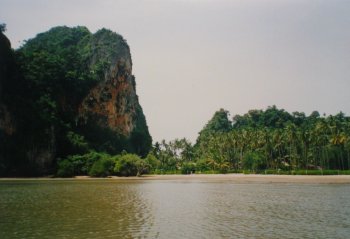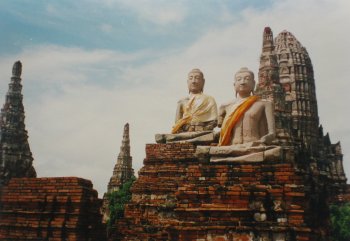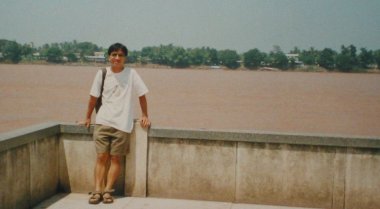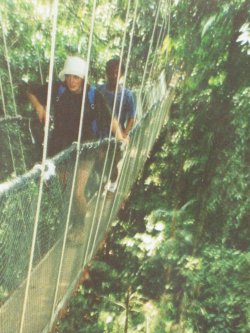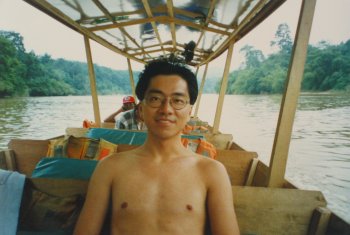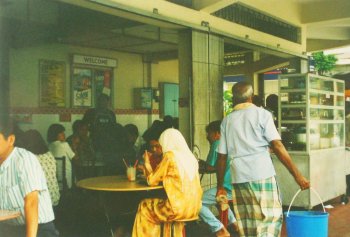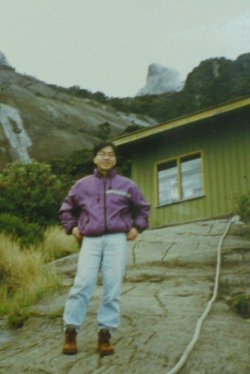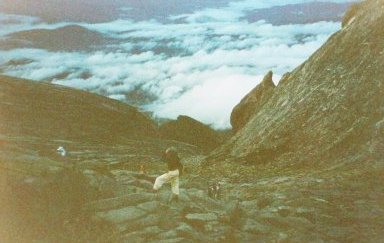Vientiane
I have crossed the bridge into Laos with Matthew, whom I have met in Nong Khai. We have shared a room in Vientiane and traveled together. The capital of Laos is more like a provincial town. The city is uncrowded with only low rise buildings, small shops and quiet streets. Most of the city is small enough to reach by foot. Here you would not find any pushy vendors or persistent hagglers like those in Thailand. Instead you would find children playing on the street, sometimes greeting to passing by foreigners with "sawatdee". It is a far cry from other bustling cities in South East Asia.
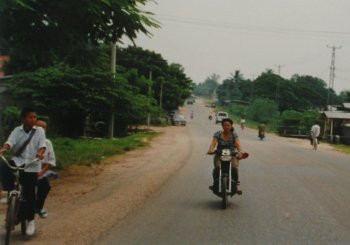
Vientiane's Victory monument Patuxai resembles Paris' Arc de Triomphe. But the wide boulevards encircling the monument have little traffic. When viewed in detail it is a concrete structure with crude finishing.
We have visited Talàat Sâo, or the Morning Market. It has hundreds of shops selling everything from daily commodities to electronic appliances and jewelry. There were many money changers. For US$100 I have exchanged 93,000kip, all in 1000 and 500 denominations. This has fattened my wallet considerably. Indeed other people even carried around blocks of money in nylon bags. For food, you have to find it in the Evening Market, which actually opens all day. I liked its French sandwich (paté in baguette) for breakfast.
Matthew was an interesting character. He firmly embraces backpacker values such as frugality and a penchant for authentic local experience. He also has a principle that if a place can be walked to, he would not take any vehicle transit. One time we had a heated debate on the street when I suggested we should spend a few dimes to ride a tuk-tuk rather than walking a few kilometer of dusty road in the afternoon heat.
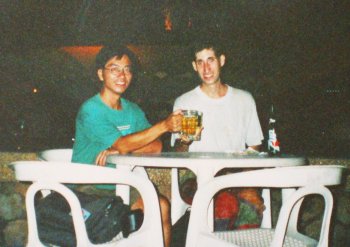
He was a reverse of me in the sense that after working in Hong Kong for some time, he gave it a miss and left for traveling (while I left Singapore to travel to Hong Kong). Me being someone from Hong Kong, I was constantly asked the mandatory question, "what do you think of Hong Kong after 1997?" Despite asking the question most people actually had a faint idea or interest in the state of affair. Matthew was the only one who understands. I had a mixed feeling about 97 and he was the only one I could have a discussion with any depth.
1996.10.02
Luang Phabang
Once the capital of the powerful Lan Xang kingdom, today Luang Phabang is a small town in the northern Laos with only 16,000 inhabitants. The city is situated amid beautiful mountain on the Mekong River. If Vientiane is provincial, Luang Phabang is more so. People are even more laid back. The sights are even smaller. The small royal palace museum opens only two hours in the morning.
There were incidents of attacks by anti-government rebels on the highway between Vientiane and Luang Phabang. Some tourists considered traveling by land not safe. While I usually downplay those threats, I have still opted for flying into Luang Phabang to bypass the road. Perhaps I should have researched the safety of flying first, for this flight was the scariest I have ever taken.
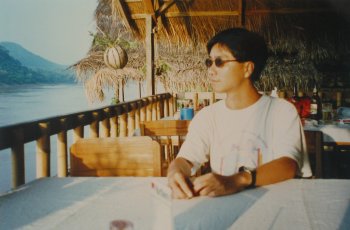
When our plane approached the mountain city, it was covered entirely in clouds. Visibility was nil. The plane descended anyway. Perhaps it was guided by some sort of radar, I told myself not to second guess the pilot. Landing gears were lowered. It continued to fly for sometime. Then the pilot backed off and the plane climbed away.
So we hovered above the mountain for sometime. It was just as cloudy when it attempted the second landing. It still has no luck and it still backed off. The third time the pilot seemed to be more determined. Landing gears were again lowered. It continued to fly in cloud for sometime. Then the pilot backed off yet again. In the fourth trial we have finally descended through the cloud and landed on the narrow city between the rivers. The landing lasted about half an hour.
* * *
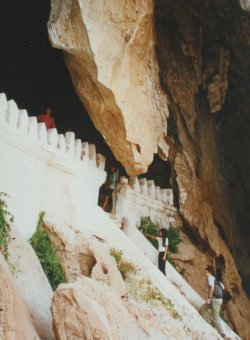
From Luang Phabang, we had an excursion to the Pak Ou cave, one hour upstream on Mekong. People have built a Buddhist shrine in the cave with hundreds of Buddha images inside. Actually the boat trip itself was more interesting than the cave and it was more scenic. We stopped by a village on the way to tour the brewing of a Lao Whisky. Lao lao is a strong spirit. We all have a sample of it.
Next day we went to the Kuang Si waterfall by a jeep. The waterfall is spectacular. We followed the guide to climb over the top of the fall and then got back from the other side. It was awful to walk across the muddy riverbed. One off us has lost a sandal to the river. The dirt road to Kuang Si runs through some villages. Village children were all excited by the passing vehicle and ran out to wave or to shout at us. The fields on hill side look beautiful.
* * *
During the long journey, I had a different sense of calendar. Days and weeks were often slipping by without notice. It suddenly occurred to me that October 4th was my birthday. My host of the guesthouse gave me surprise congratulations. I have turned 27 in Luang Phabang.
I decided to have dinner in one of the most 'luxurious' hotel in town. It was in a colonial building with tasteful decor and a beautiful balcony overlooking the street. The price was not much (alas so is the food quality). Almost all guests were tourists. Suddenly I had a reflection. I was reliving the colonial life when foreigners enjoy great living served by improvised locals. It was a bourgeoisie life in a communist country.
1996.10.05
Lao Pako
Flying back to Vientiane, I went straight from the airport to Lao Pako, a 'resort' village, about 50 km away by bus and boat. According to the tourist brochure, the bus trip should take one hour. In reality the bus made a stop in front of every shop on the way. Passengers got off to shop and came back with loads of stuff. Only then would the bus move to the next shop. 45 minutes after the bus has departed, we have traveled maybe 1 to 2 kilometers.
I got off the bus and change to a boat for a half hour ride. I had an embarrassing accident at landing. The boat dropped me off at a muddy ramp on the bank of the river. When I stepped off, one of my feet was immediately plunged into the clay soil. I had a big backpack on my back and a small backpack in front of me and one foot got sucked into the mud. It took a huge effort to regain my balance and to pull myself out.
The facilities in Lao Pako were very basic but comfortable. The bamboo house has a huge balcony for resting. There is a bar and a restaurant in a riverside hut. The few days in there, I mostly enjoyed walking in the nearby fields and villages. The weather was sunny and the air was clean. It was very quiet besides something seeing some naked boys playing in the irrigation channel.
Lao Pako was not always busy. However on the first evening there were 6 young people staying. So the resort prepared us a great buffet dinner in the riverside restaurant. We talked about Noam Chomsky, the secret bombing of Laos by the U.S. and so on. The Austrian manager joined us and shared his story of being in Libya while the U.S. has bombed it.
1996.10.08
Journey to Vietnam
After spending 10 days in the Vientiane vicinity (including Nong Khai), I was prepared to move on. In the next two days I took a long road trip stretching 800 km, spending a night in Savannkhet in the south and then continue on to Vietnam via the mountain pass at Lao Bao to arrived in Hué in central Vietnam.
Despite the impoverishment and other horror stories about appalling road conditions in Laos, the bus ride to Savannkhet was actually quite comfortable. The road was mostly paved. Perhaps the infrastructures were partly funded by foreign aid. I found many Japanese constructors working on various projects on the way.
I checked into a communist era hotel in Savannkhet. It was a grand but empty mansion. The rooms have many facilities but were poorly maintained. Their rate was very cheap for that matter.
My bus to Lao Bao departed at 5am the next morning. The bus was actually a converted truck. Benches were bolted to the truck bed as seats. There was a roof but no windows. When it rained, water came inside. Fortunately the rain was brief. There was no need to carry food. Whenever the bus stops, local people would surround the bus to sell food. I have had some delicious streamed pork bun. The road was dusty, as my T-shirt would testify. It was a white T-shirt during the departure in the morning. It became a brown T-shirt upon arrival.
We arrived in Lao Bao at noon. I was immediately surrounded by a mob of money changers, each holding a block of Vietnamese dong. I ignored them because the rate they have offered was so low. That was a mistake because it was my last chance to get rid of my leftover kip. There was no taker of Laos kip beyond that point. I should have known kip is a currency unwanted outside of Laos.
The Lao-Vietnam custom station is situated in a mountain pass about 2 km away from the town. I walked the mountain road with a British traveler, declining the motorbike transport offered. At the custom my companion has cleared in just 15 minutes. My passport, however, was looked with great suspicion. First an officer checked it. Then he consulted with other officers. Many more phone calls were made about it. Later another officer sped away on a scooter with my passport. Where was he going to I don't know. I looked at the desolated mountains around and thought this was not going to be a fun place to get stranded in. It was a big relieve when I was finally admitted after stuck at the custom for an hour and a half.
After completed the first 700km road trip in Laos, I thought the roughest part has already been passed. I could not be more wrong. The worst was yet to be experienced in Vietnam. While the Laos bus was converted from truck, it was at least a newer Japanese truck. The Vietnam bus was a wreck that looks like a relic from the soviet era. The entire antique dashboard has only a single speedometer, which was broken anyway. The seating benches were so narrow that it was tough to sit when the bus is not moving. It became a challenge to keep yourself balanced when the bus is running on the bumpy roads. The bus' windows open just below the eyeline so that all sceneries are blocked from view. The only good thing about this ride was the torture has lasted only two hours. After that I was transferred to another overcrowded minibus for another one and half hour. Toward the end, my butt has hurt so badly. I could only occasionally relieve it by lifting my body up a little from the seat using my hands.
1996.10.10
2006.12.31 - comments

